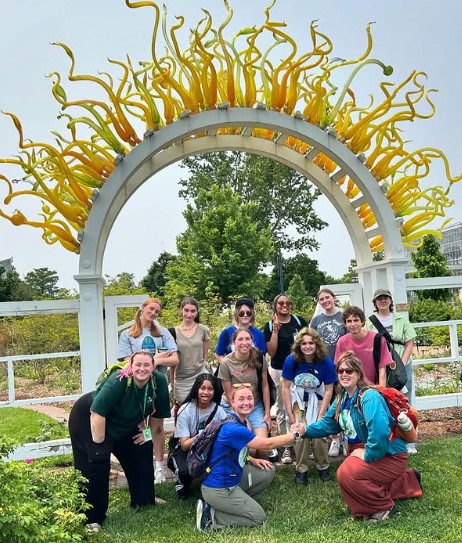
One group of like-minded, engaged, determined, and hard-working youth has made me hopeful time and time again. I am talking about the Outdoor Youth Corps (OYC), an assembly of determination that I have had the opportunity to be a part of for 4 years, participating in 9 cohorts total. Horticulture, conservation, sustainability, and community engagement are the four pillars that the OYC regularly engages in and are what I consider the legs of the table that seat human survival and consciousness towards the living Earth. Working with and being conscious about the state of the environment, my community, and the future of the green field often stirs up troublesome and anxiety-inducing emotions and could put any person in a position of being more empathetic towards our living, breathing world. I can confidently say that this meaningful program has provided opportunities to take positive action and channel feelings like concern, frustration, or uncertainty into doing something constructive, rather than feeling stuck or overwhelmed.
It can be difficult to feel hopeful during these times. Trust me, I know it is more than easy to be a pessimist and assume that tiny changes themselves don’t amount to anything. I GET IT. But stay with me here. If we all adopt that mindset, and don’t bother to do anything, then of course nothing is going to get better. To quote the Lorax, “Unless someone like you cares a whole awful lot, nothing is going to get better. It’s not.” Working with OYC as the Summer Intern has shown me that many people DO care. People WANT to make a difference. For youth especially, programs like these are so important because they offer frameworks, and education on how to bring their ideas to life. If I’m not believed by just listing experiences, then let me SHOW YOU the experiences, with the lasting benefits.
Despite being a member of the crew for 4 years, I still found myself facing challenges on the first official start day of the Summer Crew, After all, I only knew 3 returning participants really well, and the rest were individuals who I had rarely, if ever, interacted with before. Even though I didn’t know all the participants, I was excited to pay it forward by helping them discover more about their likes and dislikes and find their passion within the green field. This very impression was how OYC helped me, and being the Summer Intern, meant having an opportunity to have that influence on others. The challenge? You can’t cause a change in others until you CREATE a contribution together. But what is an impact? How could the members visualize and understand the improvements that they would be making? How could this summer benefit those we work with, but also provide the participants with something to be proud of?
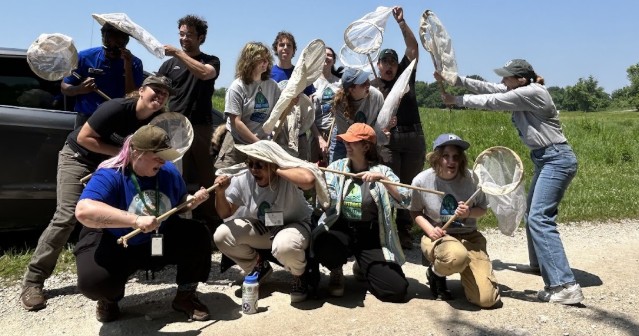
The OYC conducted an Atlas Bee Survey with the Missouri Department of Conservation.
Rather than searching for the definition of an impact throughout the season, I let the participants define it for me. At different stewardship projects, I conducted interviews with the participants one-on-one and asked them a series of questions, one of the most important being: “What do you think has been your biggest impact through OYC?” A common answer I received was the Bumble Bee Atlas Survey we conducted with the Missouri Department of Conservation. This was our first stewardship project in the field, and it really seemed to stick with the participants. Not only did the crew participate in collecting the bees, but they had the opportunity to sit and identify the different species that we located. In total, we captured and released 67 bees. While this may not seem like a huge action, the educational benefits of it were amazing. Several of the participants expressed enjoyment with passing around the different specimens and looking closely at the ID sheets. However, the biggest takeaway by the crew was the idea that their data would be used to benefit these native bee populations. The Bumble Bee survey serves as a community science project, where members of the public collect this data and submit it to the Atlas survey. Those individuals then use that data to track population trends, locations of certain species, and how to address declining or rapidly increasing populations. As someone with an interest in entomology, hearing about this impression, and how it stuck with the participants, was heartwarming.
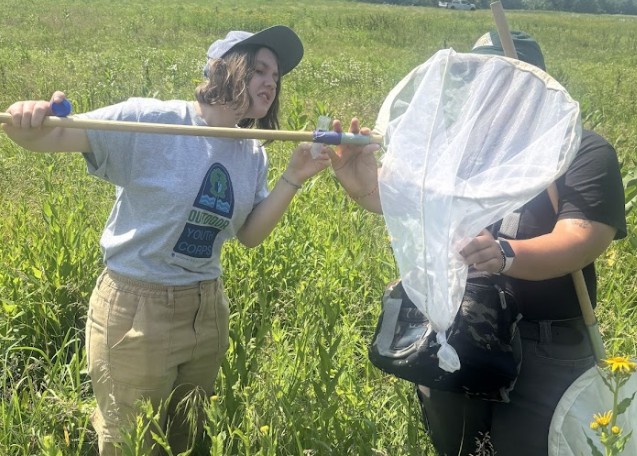
OYC participant Nona Mahew conquered her fear of bees and caught several during the survey.
Results are never just through data, though. I had the privilege to walk alongside and help one participant, Nona, who expressed a fear of bees and bugs in general. At the beginning of the survey, she was distant and didn’t like listening to the buzzing of the creatures and would often lose a bee from her net because she didn’t feel comfortable enough to ease one into the bottle. I took notice of this and suggested a compromise: if she was able to catch the bee in the net, then I could get it into the bottle. After searching relentlessly through the St. Louis County Park’s Fort Belle Fontaine prairie, we locked onto a bee. Getting it onto the net was difficult, but Nona was able to do it! From there I captured the bee inside of a vial, and just like that, Nona successfully caught her first bee. After that attempt, she gained confidence and continued to catch more and more bees, each swing of the net stronger and fiercer than the last. The progress here might not have been through data, but Nona herself has changed. She proved to herself that she could be afraid of something and conquer it, a lesson that many people don’t learn easily. Now, she could participate in a survey herself, which highlights the sustainability of teaching that ability. It felt amazing to be a part of that change, and it really was just the tip of the iceberg.
On the very next day, I had an opportunity to present an alternative viewpoint to several participants. We spent the day at the actual Fort Belle Fontaine Hiking Trail at the park, where we used the time to enjoy and explore and create connections to nature before getting into the more difficult stewardship projects to conquer. I noticed, upon walking into the beginnings of the canopy-covered trail, that there were several stalks of common milkweed (Asclepias syriaca) on the left side of the trail. This is my favorite plant not only because of the delicious smell of the flowers, but because this plant is a host to monarch butterfly (Danaus plexippus). Without milkweed, these beautiful creatures cannot exist. As I brought the crew aside and explained this connection, I was met with several odd looks. One new participant, Ellis McCurdy, spoke up.
“I used to remove these at my previous job. They were weeds. I didn’t know that caterpillars ate them.”
Then, another participant, Isi Crews, added to that comment.
“Yeah. At the farm I worked on, we cleared so much of it so we could plant more. It was really aggressive.”
I hadn’t ever thought of YOUTH removing milkweed. I didn’t realize that these methods were still taught, and that removing milkweed wasn’t seen as something incredibly detrimental. After explaining this to both of the participants, they seemed to have a different viewpoint on the plant. While we continued walking along the hiking trail, I took several moments to reflect. Other people weren’t aware of the status and life cycle of the monarch butterfly, something I work very hard to protect and preserve? I raise the caterpillars when I find them, after all! It was disheartening to think about all the caterpillars that were potentially on those removed plants, and how those practices were still being taught. But there was a silver lining. I had educated two people not to pull milkweed. Along with it, I educated ten participants on why the plant was important. This may seem insignificant, but if one individual, myself, was able to give my knowledge of the plant to ten people, what if those ten individuals when on to educate others? If each person told ten more people not to pull milkweed, then that would be 100 people now educated. And that chain would continue to expand. The value of this verbal knowledge, to be able to identify the plant and associate it with newly learned material, can create a cascade of information. If we as humans have the biggest negative impact on the land, then reversing our thinking and gaining that knowledge can create the biggest positive changes. This realization brought a smile to my face, and I can confidently say that this experience has created a lasting impact. I'll just have to wait and see what it is.
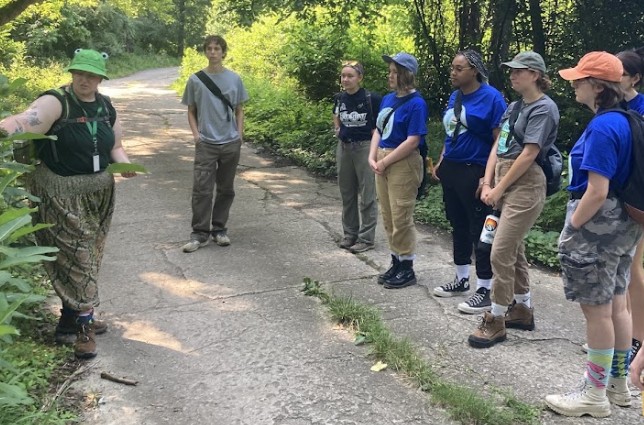
Educating the crew about common milkweed, my favorite plant and beloved host of monarch caterpillars.
We had the opportunity to work with one of my favorite partners, Tyrean with Heru Urban Farming. The reason I love this partner is because we can visualize and understand the work that goes into producing our food. Tyrean brings us in to assist with farming projects on his land at Confluence Farms, where several other farmers steward the land to create produce that is sold directly to St. Louis businesses. Heru Urban Farming, however, has an educational focus that centers around land justice, stewardship, and working with the land to provide what we need. During this workday, I had the chance to see the crew fully grasp their impact. We were tasked with harvesting 120 lbs. of kale, and 40 lbs. of collard greens. I could tell that this task daunted the participants, especially on such a hot day. Wide were the eyes of these hard-working youth, but I knew that they had the capacity to do it. And I was right.
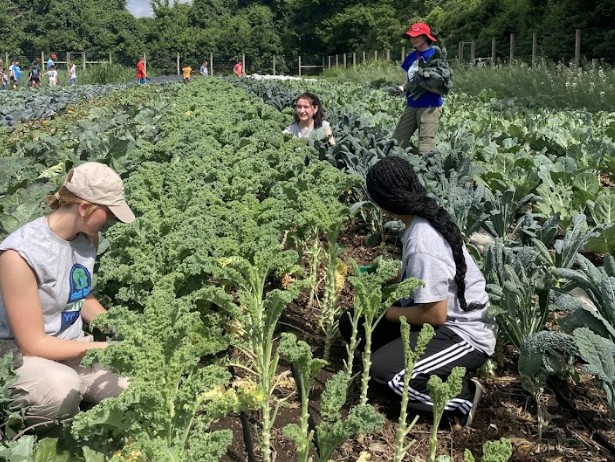
Participants Ellis McCurdy, Kristina Doyle, Jadyn Deal, and Emmy Benson harvesting kale and collard greens.
It didn’t even take the full time for the crew to harvest those crops. It happened quickly and with only three of the nine participants harvesting at a time. Because of our efficiency, we were able to do other tasks, such as leaf mulching between rows of watermelon (Heru’s specialty) and weeding between different gardening beds. The work was hard and hot, but so incredibly beneficial. Not only did we complete the initial goal we set out to do, but we excelled. The sweat and dirt covering us didn’t phase us as we fully stepped back to appreciate our work. This harvest would have taken Tyrean and his crew several hours. But we did it. For an urban farm, every minute spent is incredibly important. The participants learned that day and grew to appreciate the work that goes into making sure we all have food to eat. We physically and mentally felt this impact. It was a proud day for us, and I really do believe that they will carry this experience forward with them.
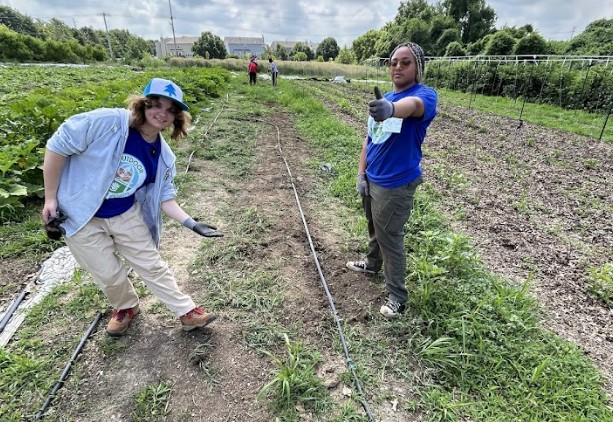
Participants Carter and Raven Villani proudly show off their hard work of weeding the field.
There was a project that was especially close to the participants’ hearts. In the first week of the crew’s orientation, the last workday, we met with Bella DeArmitt, the founder of Find Kind, a non-profit organization that connects kind people to kind volunteer opportunities, apprenticeships, and resources. Working with this partnership has been new for the OYC leadership team and participants, and even for Bella. It was her first youth outreach program. She gave the OYC a presentation on how she came to create her organization, and why doing kind things is so important. With this presentation, the OYC was given an amazing opportunity: to create our own community event to make a difference. We split the crew into groups and had them brainstorm their strengths, and how to turn those strengths into a kind action for their communities. There were several different ideas created and pitched, such as creating a community bug booth to display commonly hated bugs or creatures and explain the good sides of them, or a wood wind chime building workshop at the St. Louis Public Library. At the end of this time, the groups created a short presentation to present their ideas to the rest of the crew. After listening and voting, we decided on doing a community trash pickup event to aid in beautifying Forest Park after the devastating May tornado, which downed and damaged trees, houses, and even damaged some public buildings.
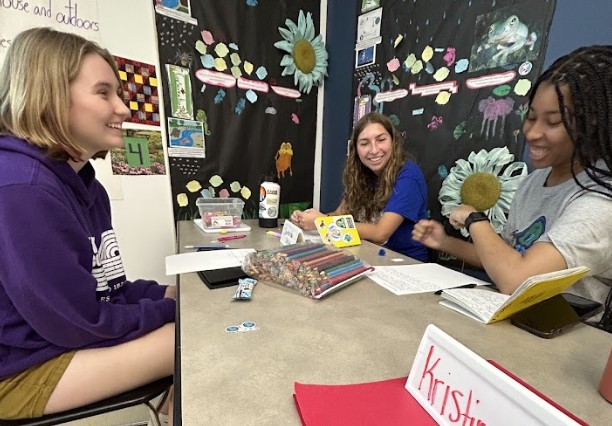
Participants Samantha Booth, Kristina Doyle, and Emmy Benson happily brainstormed their kind ideas.
The culmination of these events turned into a partnership with Forest Park Forever, where we conducted an abbreviated ‘Trash and Trails” event. On June 23rd, we met back up with Bella and picked up trash. They collected several bags to be thrown away, effectively removing debris and garbage that would have flowed directly into Missouri streams, or otherwise would have been eaten by wildlife and harmed them. The crew obviously didn’t pick up all of the trash in the world. It can be so hard to see past that gloomy aspect. But they made a difference here. Thinking that this made no change in the world would not only be pessimistic, but wrong. They saved a fish from swallowing something sharp and being unable to spawn upstream. They picked up a piece of plastic that a bird would have fed to their young, causing its death. They even picked up a plastic 6-pack soda can holder that could have made its way to the ocean and suffocated a sea turtle. It is a significant change. Every life, every sentient being on this planet has value. Preventing even one animal from being harmed in the St. Louis area is an act that should be celebrated and revered, not pushed under the carpet for “not making a big enough difference”. The crew’s many hands brought this change to life all the way from just the design phase, something that will aid them in future problem-solving tasks, and has given them the tools they need to make their own, independent, kind and helpful event. It is just like the cascade event that I talked about previously. If they all made their own event, how much trash would be picked up? How much would nature benefit? The possibilities are endless.
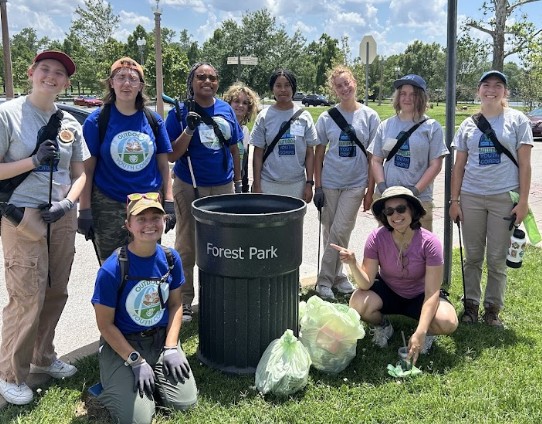
The crew posing with their retrieved trash bags, proud of their dedication.
There are important moments in everyone’s lives that dictate the kind of person that they become. Real, genuine, and beneficial actions will shape a brighter, better future. But this future doesn’t come without change. Without impact. This summer season, the OYC crew taught me that anyone can make that difference, and anyone can learn to spread that difference. All this article I have talked about how the crew experienced something. But let me tell you how much I benefited from this work. Every day, I struggle with the reality that is our world. I struggle with the darkness and fear that so many of us experience. And I’m sure that you, reader, have experienced dread before when thinking about the future. But it doesn’t have to be that way. OYC has taught me that the future is full of intelligence, compassion, and empathy for our living, breathing world. There are people who care. There are positive changes happening all the time, and all we need to do is choose to look. To see that there is hope, to see that our two hands can alter our future. Our earth sees and smiles at the youth and generations that make these differences. Thank you.
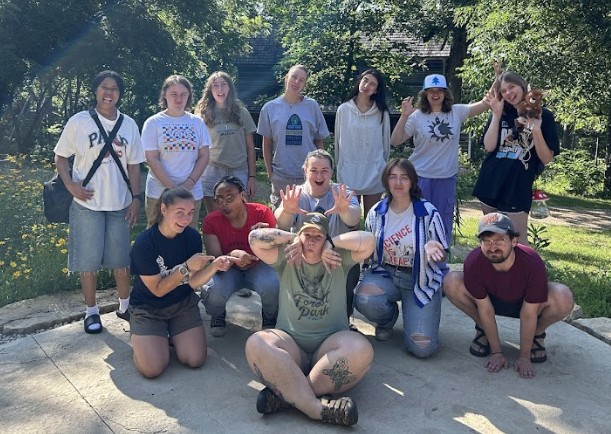
Are you or someone you know interested in the Outdoor Youth Corps? Visit our website www.mobot.org/outdooryouthcorps for more information.